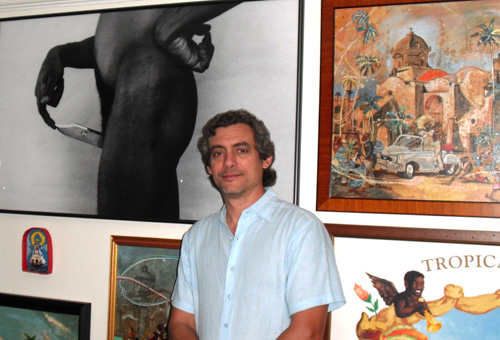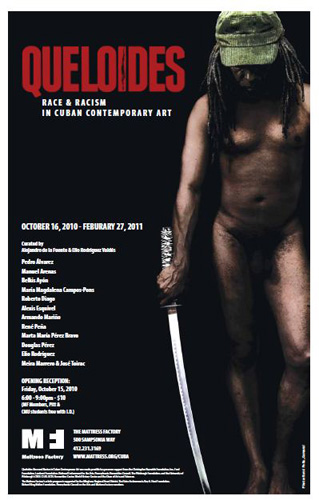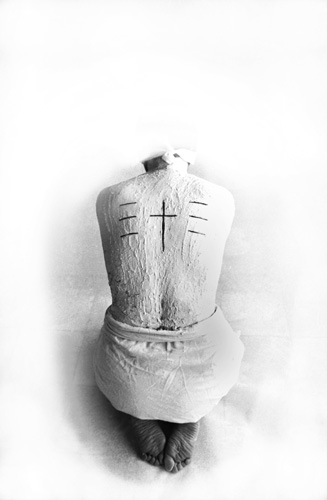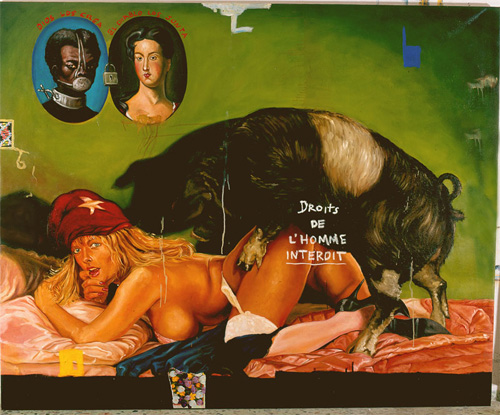The Audacity of a Cuban Curator
by Silvia Duarte / October 15, 2010 / No comments
Organizing the exhibition “Queloides: Racism and Race in Cuban Contemporary Art” has been a mix of obstacles, audacity, and adventure. The exhibit, which opens this Friday at the Mattress Factory Museum in Pittsburgh, was first shown earlier this year in Havana and the curator Alejandro de la Fuente was unable to attend. He was banned from Cuba. Later he was expelled from the country when he tried to visit family in Havana.
De la Fuente, a Professor of History and Latin American Studies at the University of Pittsburgh, has written extensively on slavery and race relations in Cuba and Latin America. His book, Nation for All: Race, Inequality and Politics in Twentieth Century Cuba is a valuable tool for understanding a country where mentioning racism is still a taboo.
Here, de la Fuente argues that the artists in this exhibition challenge the official history of Cuba, which is one of harmony and equality, by telling a different story. While celebrating a new cultural bridge between Pittsburgh and Cuba, he laments the attitude of Cuban cultural authorities and the persistence of racial inequality in a socialist society.
What inspired you to organize Queloides?
There were three previous exhibitions in Havana between 1997 and 1999: “Keloids I,” “Keloids II,” and “Neither Musicians nor Athletes.” The last two were curated by the late Cuban art critic Ariel Ribeaux.
After I finished Nation for All, my book about race and politics in Cuba, I realized there was this group of visual artists who were trying to paint what I was trying to write. But I couldn’t get hold of their paintings, I couldn’t see an image, there was no website, there was no catalog, there were no press releases. The exhibits were almost clandestine, even though they were public exhibits, so that piqued my curiosity.
I wanted to do an art exhibition because I realized that art is a space where you could do so much more in the Cuban context. Art had become the space where you could talk about racism and get around censorship.
Why the Mattress Factory?
In 2006 I learned that Ariel Ribeaux had died in Cuba from injuries he sustained during an attempted murder in Guatemala. He had been working as a journalist and editor there and returned to Cuba after the attack. I decided that Queloides should also be a homage to his contributions and a way of telling him—wherever he is—we’re not giving up, we are going to continue what you started.
In 2007 I met Elio Rodríguez, my co-curator for Queloides and I organized his exhibit at the Frick Fine Arts Gallery at the University of Pittsburgh. While Elio was in Pittsburgh, we went to the Mattress Factory. As we began to think about Queloides, we immediately thought of the Mattress Factory. It’s a place where artists can do what they want and Barbara Luderowski, its founding director, and Michael Olijnyk, its co-director, are adventurous enough to take on a project like this.
Queloide can be translated as a thick raised scar, which anyone can develop after a serious wound. Nevertheless many people in Cuba believe that black skin is particularly susceptible to them. How else does this exhibition illustrate the persistence of racial stereotypes in Cuba?
One of the threads of the exhibit illustrates the fear of blacks. If you want to experience racism in Cuba, sit at a bar in a hotel and just watch the police for a half hour. You’re going to see the police stop almost exclusively Afro-Cubans. In the minds of these policemen—some of whom are black themselves—there is a clear association between blackness and criminality. This idea is reflected in the title of a piece by Manuel Arenas: “Cuidado hay Negro” (Look out, there’s a black man.)
You also can see that fear of black people in the work of photographer René Peña, whose image we are using to promote the exhibit. In this image a black man who looks very tender has a sword in his hands. This shows that it doesn’t matter how tender they are, it doesn’t matter how human they are, there’s always danger associated with Afro-Cubans.
Another theme in the exhibition seems to be the importance of African descent.
Many of the artists are very interested in highlighting how central Africa is to Cuba as a nation. They want to show that we are African. Everybody accepts this idea in Cuba, but only at a rhetorical level: we even have a saying: “Quien no tiene de Congo tiene de Carabalí” (Those who don’t come from the Congo come from the Carabalí). The problem is that you don’t find the real descendants of people from the Congo or Carabalí in the hotels, you don’t find them in the best jobs, and you don’t find them in the offices. What some of these artists are trying to do is to put Africa in front of our face and say “Look, this is who we are.”
I suspect that the artists are writing a critical revisionist history of the Cuban nation instead of the typical grand narrative of a harmonious nation in which we all get along and are a happy unified people. What they’re saying is, “There is another history—a history of rape and violence and a history linked to slavery—and that’s our history too. We have to recover the gods, we need to recover the languages we lost.”
What else we can see in the exhibition?
Some artists simply make fun of the persistence of racist stereotypes and racist ideas, such as the idea that black people are sexually powerful or dangerous. So their work is quite explicit about these things and it really doesn’t take a rocket scientist to understand it once you understand where we’re coming from.
Did the Cuban revolution fail to eliminate racism because there weren’t meaningful policies against discrimination?
It’s such a paradox because the Cuban revolution did much more than any other event in the Americas to eliminate social inequalities, including racial inequalities. By the 1980s in Cuba, racial gaps had really closed in some key social indicators, such as life expectancy and access to education or healthcare. Racial inequality was quite minimal in Cuba compared to places like Brazil or the United States.
The problem is that after many years of talking about racism as a “solved issue,” the issue became a taboo in public discourse. If you look at the Cuban press or the public debates, there are almost no references to racism, except to note how successful Cuba has been in eliminating it or how racist the United States was. So those who insisted on talking about issues of race were basically characterized as counter-revolutionaries – people who were creating division within the Cuban family. And that was a tragedy.
In the early 1990s, numerous cultural actors including some artists who are showing work in this exhibition, began denouncing racial discrimination in Cuba. That was unthinkable in the 80s. What prompted this greater awareness?
In the 1990s the Cuban government lost the power to maintain the welfare state as the Soviet Union, its financial backer, broke apart. When the government didn’t have the resources to distribute goods the way it had in the 1970s and 80s racism became obvious.
All these artists, who were coming out of art school in the late 1980s or so, found a world that they didn’t understand. They had grown up in a place that was mostly egalitarian, that had a commitment to ideals of social solidarity, and suddenly that place began to change. Cuba became more global and the economy was dollarized in the 1990s.
It didn’t really matter if you were a good person or an educated person because all that mattered was if you had dollars or not. Of course what happened was whites had more access to dollars than blacks because of the composition of the Cuban-American community, which sent dollars to their families. That created a huge income gap between whites and blacks that didn’t exist in the 80s.
You’ve been banned from Cuba due to the exhibition. What happened?
We presented this project to Cuba’s cultural authorities in 2008. I wanted to show it first in Havana because I didn’t want to do it only for foreign consumption. I understood that this was a polemic project, but I also thought that the situation had changed in the island. Racism is something that has been recognized even by Fidel Castro, who had acknowledged publicly that racism has not been solved.
The cultural authorities were never quite enthusiastic about the project, but they said we could do it. The authorities had no chance to select the artists. I think several of the bureaucrats started having nightmares that this might endanger their positions and their privileges or that state security may call them. Maybe they did call them.
Also, this is the first time in post-revolutionary Cuba that the word “racism” has appeared in the title of an exhibition.
Yes, and they didn’t know how to deal with that. As 2009 progressed, they tried to kill the project saying that I was being financed by the counter-revolution, which is something they always say when they want to silence you. They actually said this to some of the artists too.
I was very clear from the very beginning and said: “Look I’m not going to ask for money from the governmental agencies that do political work.” This exhibit was conceived during the Bush administration and there was no way I was going to take a dime from those sources. So I approached private foundations. However, the authorities began to spread the rumor that I could be detained if I traveled to Havana.
Some artists even suggested we forget about the exhibit in Cuba and just go to the Mattress Factory. But I wrote a public letter to the artists and to the cultural authorities saying, “Absolutely not, don’t cancel the exhibit. If I’m the problem, I’m out, I’m not coming, that’s fine. You don’t have to put my name there, I don’t care. I just care about the project.” Literally I begged the artists to stay in the exhibition and to do it in Havana.
At the end the authorities wanted to print the brochure without my texts or my name, and I refused to do it. The exhibition didn’t have a brochure.
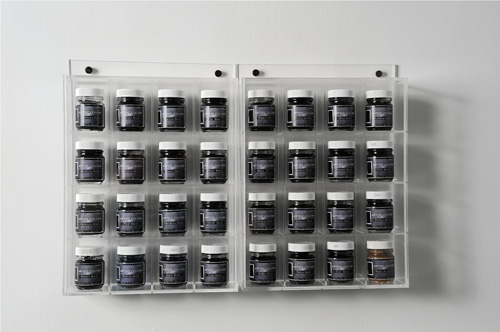
Juicio Cromático by Manuel Arenas
In June you went to see your family and you were expelled from Cuba.
I tried to go after the exhibit had closed and they kicked me out. I was in the airport and they took my passport, took me to an office, and escorted me back to the airplane with my wife and daughter. We have always tried to teach our daughter to love Cuba and here she saw repression for the first time in her short life. She was crying and I told her, “Cry later, but not here. Don’t show them, hold it.”
But you were holding it too, I bet.
We both held it. When they were taking us back to the airplane I just told the guard “I’m not a hater, but I’m not going to forget, I will remember.”
So the price you paid for doing this was really high.
I started to called it “la osadía de hacer ‘Queloides’” (the audacity of doing ‘Queloides.’) It’s a huge price to pay. This is about my family, my friends, my landscapes, and my sea. But I thought it was a price I had to pay in order to create a conversation that is healthy for Cuban society. The official media outlet covered the exhibit with silence, but I know that the society talked about it.
There is a blogging revolution in Cuba. How have the bloggers covered the exhibition?
A lot of people went to see the exhibit. The difference between Ariel’s exhibition in the 1990s and now is that now you have this new world of people who post online every day. I was here in Pittsburgh, and I got an invitation by email from Havana. I was laughing. Even though the Internet is not that big in Cuba, all these bloggers and Internet users are helping to change the current situation. Before them, the government had a monopoly over public speech. So on one hand you have the official silence, and on the other hand there’s this sort of subterranean world where people are passing information around. One guy wrote “Queloides: Condenada al silencio” (Queloides: Condemned to Silence) on his blog.
We can’t deny that here in the United States and in Pittsburgh, there is also racism. What do you expect from the people who are going to see the exhibition here?
There is something pretty universal about racism. Racism is an epistemological assumption of the western culture. Some of the stuff we are doing is a pretty universal, so it can be understood by people in the United States, São Paulo, or Johannesburg. In that sense I really hope that this exhibit is not only going to help people know more about Cuba, but also to learn more about their own world. Hopefully they will begin to think that some of these assumptions, these stereotypes, are not just a problem in Havana or Pittsburgh.
Do you want to know more about Cuban freedom of speech? Read Kilobytes of Discord and Blogging under Fear
Queloides runs through February 27, 2011.
The artists, who were all born in Cuba, include Pedro Álvarez, Manuel Arenas, Belkis Ayón, María Magdalena Campos-Pons, Roberto Diago, Alexis Esquivel, Armando Mariño, René Peña, Marta María Pérez Bravo, Douglas Pérez, Elio Rodríguez, and José Toirac/Meira Marrero.
Read Silvia’s bio.

